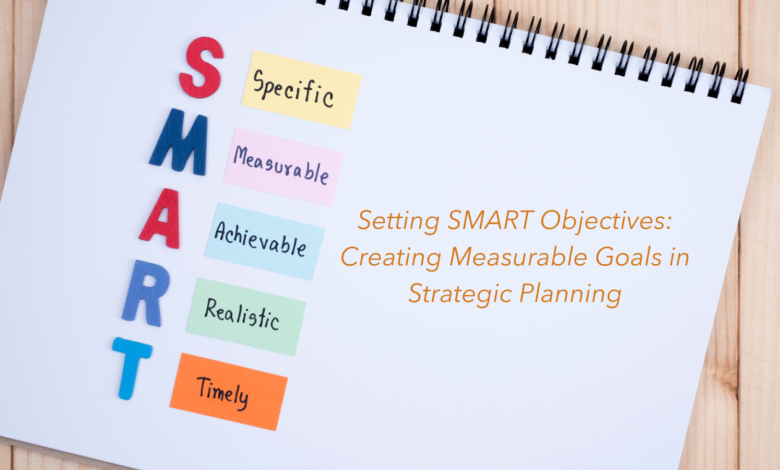Setting SMART Objectives: Creating Measurable Goals in Strategic Planning

In today’s competitive business landscape, strategic planning is crucial for organizations seeking sustained growth and success. However, setting vague or immeasurable goals can derail even the most well-intentioned strategies. By embracing the SMART approach – Specific, Measurable, Achievable, Relevant, and Time-bound objectives – organizations can channel their efforts toward tangible outcomes, foster accountability, and drive continuous improvement. This comprehensive guide delves into the power of SMART objectives, providing actionable insights and real-world examples to elevate your strategic planning prowess.
The Importance of SMART Objectives in Strategic Planning
In today’s dynamic business landscape, strategic planning is not just a luxury but a necessity for organizations seeking long-term growth and sustainability. However, embarking on this journey without a robust framework is akin to navigating uncharted territory blindfolded—you might eventually stumble upon your destination, but the path will be riddled with inefficiencies and wasted efforts. This is where the power of SMART objectives comes into play, acting as a beacon that illuminates the path to strategic success.
By distilling aspirations into Specific, Measurable, Achievable, Relevant, and Time-bound targets, SMART objectives eliminate ambiguity and sharpen focus, fostering a culture of accountability and progress tracking. Numerous studies have highlighted the positive impact of goal-setting on organizational performance, underscoring the pivotal role SMART objectives play in driving measurable outcomes.
For organizations seeking a comprehensive strategic planning service tailored to their unique needs, embracing the SMART framework can be a game-changer. By partnering with experienced consultants who specialize in crafting SMART objectives, companies can streamline their strategic planning processes, ensuring that every goal is meticulously defined, quantifiable, attainable, aligned with their vision, and bound by clear timelines. This structured approach not only enhances the likelihood of achieving strategic objectives but also fosters a culture of continuous improvement and adaptability.
Beyond the Basics: Diving Deep into Each Element of SMART
While the SMART acronym is ubiquitous in the realm of strategic planning, truly comprehending and leveraging each element is paramount for maximizing its potential. Let’s delve deeper into the nuances of Specificity, Measurability, Achievability, Relevance, and Time-bound components to unlock their full transformative power.
Specificity
Specificity is the foundation upon which all other elements are built. It involves refining goals to a level of granular detail that leaves no room for interpretation. A vague objective like “increase sales” lacks the precision required for effective execution.
By infusing your objectives with specificity, you eliminate ambiguity and ensure that every team member understands precisely what needs to be accomplished. This clarity of purpose not only enhances focus but also facilitates better resource allocation and task prioritization.
Measurability
The ability to quantify progress is a hallmark of successful strategic planning. Without measurable objectives, it becomes challenging to gauge the efficacy of your efforts or make data-driven adjustments. Integrating metrics such as Key Performance Indicators (KPIs), revenue targets, or customer acquisition rates into your objectives ensures that progress can be tracked and evaluated objectively.
By embracing measurability, you gain invaluable insights into what’s working and what needs to be adjusted, enabling agile decision-making and course correction when necessary.
Achievability
While ambition is commendable, objectives that are unrealistic or unachievable can demoralize teams and impede progress. Achievability is about striking a balance between aspirational goals and practical constraints. It involves conducting a thorough assessment of available resources, skill sets, and potential roadblocks, ensuring that objectives are challenging yet attainable.
Achievable objectives not only foster a sense of empowerment and motivation within teams but also contribute to maintaining morale and engagement levels. When employees perceive goals as achievable, they are more likely to rally behind them and actively participate in their pursuit.
Relevance
Relevance ensures that objectives are aligned with the overarching strategic vision and market dynamics. Irrelevant goals, no matter how well-defined or measurable, represent a misallocation of resources and can derail organizational focus. By continuously validating the relevance of objectives, organizations can maintain a razor-sharp focus on initiatives that drive tangible value.
Relevant objectives resonate across the organization, fostering a sense of collective purpose and ensuring that everyone is pulling in the same direction. When teams understand how their efforts contribute to the larger strategic picture, they are more likely to remain motivated and engaged, further enhancing the chances of success.
Time-bound
Deadlines are the catalysts that propel objectives from concept to reality. Without a sense of urgency, even the most well-intentioned plans can languish in perpetual limbo. Time-bound objectives infuse a sense of momentum and accountability, fostering a culture of execution and continuous improvement.
Google, for instance, is renowned for its Objectives and Key Results (OKRs) framework, which sets ambitious yet achievable goals with strict quarterly deadlines. This time-bound approach has been a driving force behind their sustained innovation and market dominance.
By incorporating time-bound parameters into your objectives, you instill a sense of urgency and create a structured timeline for progress tracking and course correction. This not only ensures that objectives are achieved within the desired timeframe but also fosters a culture of discipline and accountability across the organization.
Integrating SMART Objectives into Your Strategic Planning Process
Embedding SMART principles into your strategic planning process is a matter of thoughtful implementation. It begins with a collaborative goal-setting phase, where stakeholders from various departments contribute their insights and expertise to craft objectives that resonate across the organization.
Next, it’s crucial to ensure that these objectives are cascaded down to individual teams and employees, fostering a sense of collective ownership and accountability. Regular progress check-ins and course corrections should be built into the process, allowing for agility and adaptability in the face of changing market conditions or unforeseen challenges.
By involving key stakeholders and cascading objectives throughout the organization, you foster buy-in and ensure that everyone is working towards a common purpose. This collaborative approach not only enhances overall alignment but also facilitates a continuous feedback loop, enabling real-time adjustments and course corrections as needed.
Case Study: A Comparative Analysis
The impact of SMART objectives on strategic success is best illustrated through a comparative analysis. Consider the contrasting fortunes of two companies operating in the same industry:
Case Study 1: British Airways’ Turnaround Strategy
Background: In the late 1970s, British Airways (BA) faced severe operational challenges, including financial losses, poor customer service, and a demotivated workforce. The airline was on the brink of collapse, prompting a need for a comprehensive strategic overhaul.
Implementation of SMART Objectives:
- Specific: BA identified clear and specific goals focused on improving customer service, profitability, and market share.
- Measurable: Objectives were quantified, such as achieving a specific profit margin and customer satisfaction score.
- Achievable: The goals were ambitious yet achievable, considering BA’s resources and market conditions.
- Relevant: Each objective is aligned with the broader aim of transforming BA into a world-class carrier.
- Time-bound: The turnaround strategy had defined timelines for each milestone, facilitating focused efforts and timely adjustments.
Impact: The implementation of SMART objectives led to a remarkable turnaround for British Airways. Within a few years, BA went from facing near-bankruptcy to becoming one of the most profitable and respected airlines globally. This success was evidenced by significant improvements in customer satisfaction, profitability, and operational efficiency.
Case Study 2: Domino’s Pizza’s Reinvention in 2009
Background: By 2009, Domino’s Pizza faced declining sales and negative customer feedback on the quality of their pizza. The company’s market share was shrinking, and there was an urgent need for a strategic shift to revive the brand and its products.
Implementation of SMART Objectives:
- Specific: Domino’s set specific goals to improve the taste of their pizzas, enhance customer service, and strengthen their market position.
- Measurable: They established measurable targets for customer satisfaction ratings and sales growth.
- Achievable: While the objectives were challenging, they were within reach through dedicated research and development efforts and customer engagement strategies.
- Relevant: The goals were highly relevant, addressing the core issues that had led to the brand’s decline.
- Time-bound: Domino’s is committed to achieving these objectives within a specified timeframe, adding urgency to their efforts.
Impact: The focused approach resulted in a comprehensive overhaul of their pizza recipe, which was widely publicized through a bold marketing campaign. This transparency and commitment to quality led to a significant increase in customer satisfaction and sales. By the end of the following quarter, Domino’s reported a 14.3% increase in same-store sales, marking one of the most successful turnarounds in the fast-food industry.
These case studies of British Airways and Domino’s Pizza exemplify the transformative power of SMART objectives in strategic planning. By setting goals that are Specific, Measurable, Achievable, Relevant, and Time-bound, both companies not only addressed their immediate challenges but also laid a foundation for sustained success, demonstrating the critical role of SMART objectives in achieving strategic success.
Advanced Tips for Setting and Revisiting SMART Objectives
1. Embrace Agility: Strategic planning is an iterative process, and SMART objectives should be revisited and adjusted as circumstances evolve. Encourage a culture of continuous improvement and adaptability by regularly reevaluating objectives and making necessary adjustments to align with changing market dynamics or organizational priorities.
2. Leverage Technology: Utilize specialized tools and software to streamline the goal-setting process, track progress, and disseminate objectives across teams for improved visibility and accountability. Leveraging technology can enhance collaboration, data-driven decision-making, and overall efficiency in managing SMART objectives.
3. Foster a Growth Mindset: Promoting a growth mindset within your organization is crucial for embracing SMART objectives. Encourage a culture of learning, where setbacks are viewed as opportunities for growth and improvement, fostering a resilient and adaptive workforce.
4. Celebrate Milestones: Recognizing and rewarding the achievement of milestones can reinforce positive behaviors and foster a sense of accomplishment, further fueling motivation and commitment. Celebrating successes, no matter how small, can help sustain momentum and drive continuous progress.
Frequently Asked Questions
1. How do you ensure that SMART objectives remain flexible in a rapidly changing market?
While specificity is crucial, it’s essential to strike a balance between granular detail and adaptability. Regularly revisiting and adjusting objectives in response to market shifts can help maintain relevance and prevent rigidity. Additionally, incorporating contingency plans and scenario-based planning can enhance agility.
2. Can SMART objectives be applied to personal career planning, and if so, how?
Absolutely! The principles of SMART objectives are universally applicable, making them an invaluable tool for personal growth and career advancement. By setting specific, measurable, achievable, relevant, and time-bound goals related to skill development, performance targets, or professional aspirations, individuals can chart a clear path toward their desired outcomes.
3. What are common pitfalls in setting SMART objectives, and how can they be avoided?
One common pitfall is setting objectives that are overly ambitious or unrealistic, leading to frustration and demotivation. To avoid this, it’s crucial to conduct a thorough assessment of available resources and potential constraints during the achievability phase. Another pitfall is failing to revisit and adjust objectives as circumstances change, resulting in irrelevance or stagnation. Implementing regular review cycles and fostering a culture of continuous improvement can mitigate this risk.
Take the Next Step Towards Strategic Success
Implementing SMART objectives is a game-changer in the realm of strategic planning. By crafting goals that are specific, measurable, achievable, relevant, and time-bound, organizations can channel their efforts toward tangible outcomes, eliminate ambiguity, and foster a culture of accountability and progress tracking.
Don’t let your strategic aspirations remain abstract notions – take action today by revisiting your objectives through the lens of SMART, and unlock the potential for sustained growth and market dominance. Embrace agility, leverage technology, foster a growth mindset, and celebrate milestones along the way. Success in strategic planning is within your reach when you harness the power of SMART objectives.



